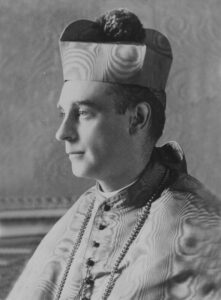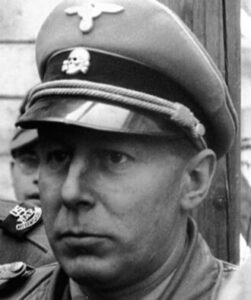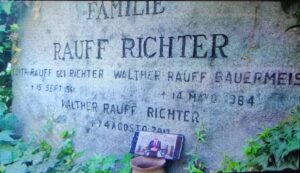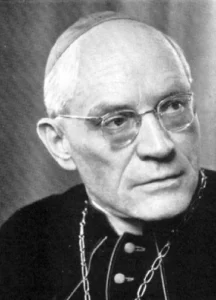Hudal, Alois Karl, born 31-05-1885,  the son of a shoemaker, hailed from the Austrian city of Graz, where he studied theology between 1904 and 1908. Alois was ordained to the priesthood on 19-07-1908. Though the professorate promised to him at Vienna’s University
the son of a shoemaker, hailed from the Austrian city of Graz, where he studied theology between 1904 and 1908. Alois was ordained to the priesthood on 19-07-1908. Though the professorate promised to him at Vienna’s University  was never given, Hudal became a noted specialist on the liturgy, doctrine and spirituality of the Slavic speaking Eastern Orthodox Churches. Hudal ministered as a parish chaplain in Kindberg, before leaving to study in Rome. In 1911, he became a doctor in theology in Graz. After completing his doctorate studies, he entered the Pontifical College of Santa Maria dell’Anima in Rome
was never given, Hudal became a noted specialist on the liturgy, doctrine and spirituality of the Slavic speaking Eastern Orthodox Churches. Hudal ministered as a parish chaplain in Kindberg, before leaving to study in Rome. In 1911, he became a doctor in theology in Graz. After completing his doctorate studies, he entered the Pontifical College of Santa Maria dell’Anima in Rome  where he served as a chaplain between 1911 and 1913, attending courses in Old Testament at the Biblical Institute. There he took his second doctoral degree, on “The Religious and Moral Ideas of the Book of Proverbs”. This dissertation was published in 1914. He took residence in the faculty for Old Testament studies at the University of Graz in 1914.
where he served as a chaplain between 1911 and 1913, attending courses in Old Testament at the Biblical Institute. There he took his second doctoral degree, on “The Religious and Moral Ideas of the Book of Proverbs”. This dissertation was published in 1914. He took residence in the faculty for Old Testament studies at the University of Graz in 1914.
An assistant military chaplain during a period of service in the First World War, in 1917, Hudal published his sermons to the soldiers, in which he expressed the idea that “Loyalty to the Flag is Loyalty to God”, though also warning against “National Chauvinism” at that time. In 1923, Hudal was nominated as rector of the Collegio Teutonico di Santa Maria dell’Anima in Rome,  a theological seminary for German and Austrian priests where he had lodged as a Doctorate Student. In 1930, he was appointed a consultant to the Holy Office by Cardinal Rafael Merry del Val,
a theological seminary for German and Austrian priests where he had lodged as a Doctorate Student. In 1930, he was appointed a consultant to the Holy Office by Cardinal Rafael Merry del Val,

 whom Hudal in his memoirs considered a “grand seigneur of the Church”. On 01-06-1933, Hudal was elected as Titular Bishop of Aela and received his episcopal consecration from Cardinal Eugenio Maria Giuseppe Giovanni Pacelli Pius XII
whom Hudal in his memoirs considered a “grand seigneur of the Church”. On 01-06-1933, Hudal was elected as Titular Bishop of Aela and received his episcopal consecration from Cardinal Eugenio Maria Giuseppe Giovanni Pacelli Pius XII 
 on June 18, who succeeded Cardinal Merry del Val as the Cardinal protector of the German national church of Rome. Hudal was furthermore a protégé of Theodor Cardinal Innitzer,
on June 18, who succeeded Cardinal Merry del Val as the Cardinal protector of the German national church of Rome. Hudal was furthermore a protégé of Theodor Cardinal Innitzer, 
 ten years his elder and Archbishop of Vienna from 1932 till 1955. Bishop Hudal’s activities following the Second World War caused a press scandal in 1947, after he was accused of leading a Nazi smuggling ring by the “Passauer Neue Presse”, a Catholic newspaper,
ten years his elder and Archbishop of Vienna from 1932 till 1955. Bishop Hudal’s activities following the Second World War caused a press scandal in 1947, after he was accused of leading a Nazi smuggling ring by the “Passauer Neue Presse”, a Catholic newspaper,  but he only resigned as rector of Santa Maria dell’ Anima in 1952, under pressure from the German and Austrian bishops and the Holy See. In January 1952, the Bishop of Salzburg told Monseigneur Hudal that the Holy See wanted to dismiss him. In June, Hudal announced to the Cardinal protector of Santa Maria dell’Anima that he had decided to leave the college, though disapproving of the Church allegedly being governed by the Allies. He resided afterwards in Grottaferrata, near Rome, until his death on 13-05-1963, at the age of 78. Hudal never gave up in trying to obtain an amnesty to Nazis. Despite his protests against anti-Semitism in the 1930’s, in his memoirs, with full knowledge of the Holocaust as of 1962, the “Brown Bishop” said of his actions in favour of war criminals and genocide perpetrators and participants: “I thank God that he opened my eyes and allowed me to visit and comfort many victims in their prisons and concentration camps and to help them escape with false identity papers” – where these so called “victims” were in fact Axis prisoners of war and their “concentration camps” allied detention camps.
but he only resigned as rector of Santa Maria dell’ Anima in 1952, under pressure from the German and Austrian bishops and the Holy See. In January 1952, the Bishop of Salzburg told Monseigneur Hudal that the Holy See wanted to dismiss him. In June, Hudal announced to the Cardinal protector of Santa Maria dell’Anima that he had decided to leave the college, though disapproving of the Church allegedly being governed by the Allies. He resided afterwards in Grottaferrata, near Rome, until his death on 13-05-1963, at the age of 78. Hudal never gave up in trying to obtain an amnesty to Nazis. Despite his protests against anti-Semitism in the 1930’s, in his memoirs, with full knowledge of the Holocaust as of 1962, the “Brown Bishop” said of his actions in favour of war criminals and genocide perpetrators and participants: “I thank God that he opened my eyes and allowed me to visit and comfort many victims in their prisons and concentration camps and to help them escape with false identity papers” – where these so called “victims” were in fact Axis prisoners of war and their “concentration camps” allied detention camps.
After the end of World War II, Hudal possibly in collaboration with Argentina and with CIA funding, established a network of rats that helped prominent Nazi leaders evade prosecution, under which SS Standartenführer Walter Rauff 
 , Adolf Otto “Siggi-Eichmann Eichmann
, Adolf Otto “Siggi-Eichmann Eichmann  , Rudel, Hans Ulrich “Eagle of the East Front”,
, Rudel, Hans Ulrich “Eagle of the East Front”,  and, Josef Rudolf “Angel of Death” Mengele
and, Josef Rudolf “Angel of Death” Mengele 

Death and burial ground of Hudal, Alois Karl.




Many took advantage of this opportunity and fled to South America. Hudal himself saw this assistance to many wanted German soldiers, scientists, and others as a humanitarian undertaking and a means of protecting them from unfair “victor’s justice.”In 1947, Hudal was suspended by order of Pope Pius XII and after the intervention of Cardinal Giuseppe Siri,

 and his Vatican diplomatic passport was confiscated. Hudal settled in Grottaferrata, near Rome, where he had bought a villa with an inheritance from wealthy Austrian relatives, and died there 13-05-1963, age 78, in Rome, Italie. He defended his aid to Nazi
and his Vatican diplomatic passport was confiscated. Hudal settled in Grottaferrata, near Rome, where he had bought a villa with an inheritance from wealthy Austrian relatives, and died there 13-05-1963, age 78, in Rome, Italie. He defended his aid to Nazi  “victor’s justice” by the Allies and the Soviet “Bolsheviks.”
“victor’s justice” by the Allies and the Soviet “Bolsheviks.” 
Alois Karl Hudal is buried at the Teutonic Cemetery in Vatican City. Via della Sacrestia, 00120 Città del Vaticano Rome, Italië.

















Leave a Reply